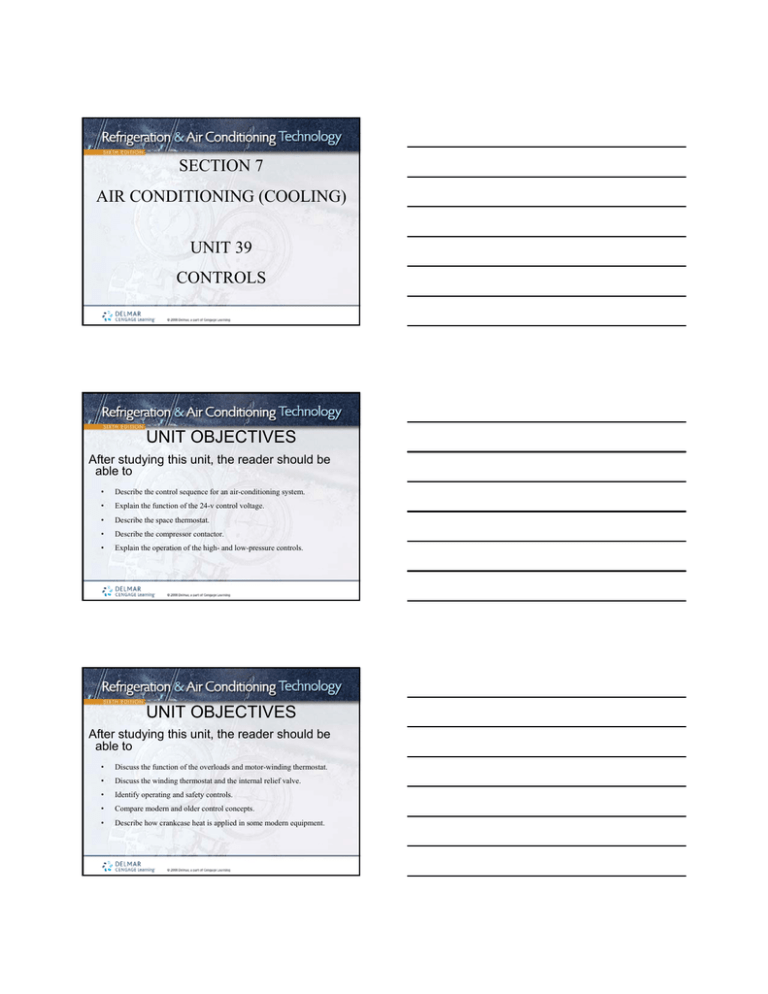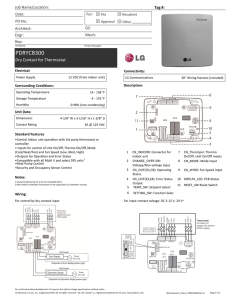Unit 39 Handout
advertisement

SECTION 7 AIR CONDITIONING (COOLING) UNIT 39 CONTROLS UNIT OBJECTIVES After studying this unit, the reader should be able to • Describe the control sequence for an air-conditioning system. • Explain the function of the 24-v control voltage. • Describe the space thermostat. • Describe the compressor contactor. • Explain the operation of the high- and low-pressure controls. UNIT OBJECTIVES After studying this unit, the reader should be able to • Discuss the function of the overloads and motor-winding thermostat. • Discuss the winding thermostat and the internal relief valve. • Identify operating and safety controls. • Compare modern and older control concepts. • Describe how crankcase heat is applied in some modern equipment. CONTROLS FOR AIR CONDITIONING • • • • • • Must correctly control the indoor fan, outdoor fan, and compressor Indoor fan must be on when the compressor is operating Outdoor fan is often on when compressor operates Indoor fan may operate continuously Thermostat – Operating control High-pressure switch – Safety control A non-adjustable high pressure control Connected to the high pressure side of the system * This device is usually connected in the control circuit PRIME MOVERS – COMPRESSORS AND FANS • • • • • Consume the most power Operate at high voltage Control circuits are usually 24 V Electronic controls more economical than before Controls for convenience, comfort, and efficiency LOW-VOLTAGE CONTROLS • • • Low voltage provided by a transformer Controls the operation of devices that, in turn, control the system compressor and fans Example: When a low-voltage contactor coil is energized, contacts close, energizing the system compressor Line voltage supplied to the primary winding of the transformer Low voltage (24v) generated at the secondary winding of the transformer OPERATING CONTROLS FOR OLDER AIR-COOLED SYSTEMS • • • • Thermostat controls space temperature Fan relay starts and stops the indoor fan Compressor contactor starts and stops the compressor and outdoor fan Compressor starting and running circuits SAFETY CONTROLS FOR OLDER AIR-COOLED SYSTEMS • • • • • High-pressure control Low-pressure control Compressor overload protection Internal motor protection Short-cycle protection OPERATING CONTROLS FOR MODERN EQUIPMENT • • • Electronic programmable thermostats Fan relays are smaller than older ones Starting circuit – Fewer components – Run capacitor in series with the start winding – PTC-Positive temperature coefficient SAFETY CONTROLS FOR MODERN EQUIPMENT • • Motor temperature control – Motor winding thermostat – Dirty condenser – Overcurrent situations – Short cycling Loss of charge protection – Low pressure cut-out – Located in the liquid line ELECTRONIC CONTROLS AND AIR-CONDITIONING EQUIPMENT • • • Can monitor high-voltage conditions – Higher voltages will cause lower currents to flow – Overloads will not rip on low current Can cut out the compressor during low-voltage conditions Some solid-state boards have a self-diagnostic feature SUMMARY - 1 • Air conditioning system controls cycle the compressor, condenser fan motor and indoor fan motor on and off at the proper time Typically, the outdoor fan motor and indoor fan motor are operating whenever the compressor is in operation The thermostat controls the operation of the major system components based on space temperature Typical residential systems are controlled by low voltage circuits • • • SUMMARY - 2 • • • Fan relays control the operation of the indoor fan motor Contactors control the operation of the compressor and the condenser fan motor Safety controls for older air-cooled systems include the high pressure switch, low pressure switch, compressor overload, internal motor protection and short-cycle protection SUMMARY - 3 • • • • Newer systems use motor protection controls in the event of dirty condensers, short cycling, overcurrent conditions or low charge protection New electronic thermostats provide more accurate temperature control Electronic controls can protect systems from both high and low voltage conditions Solid-state controls often have self-diagnosing features

